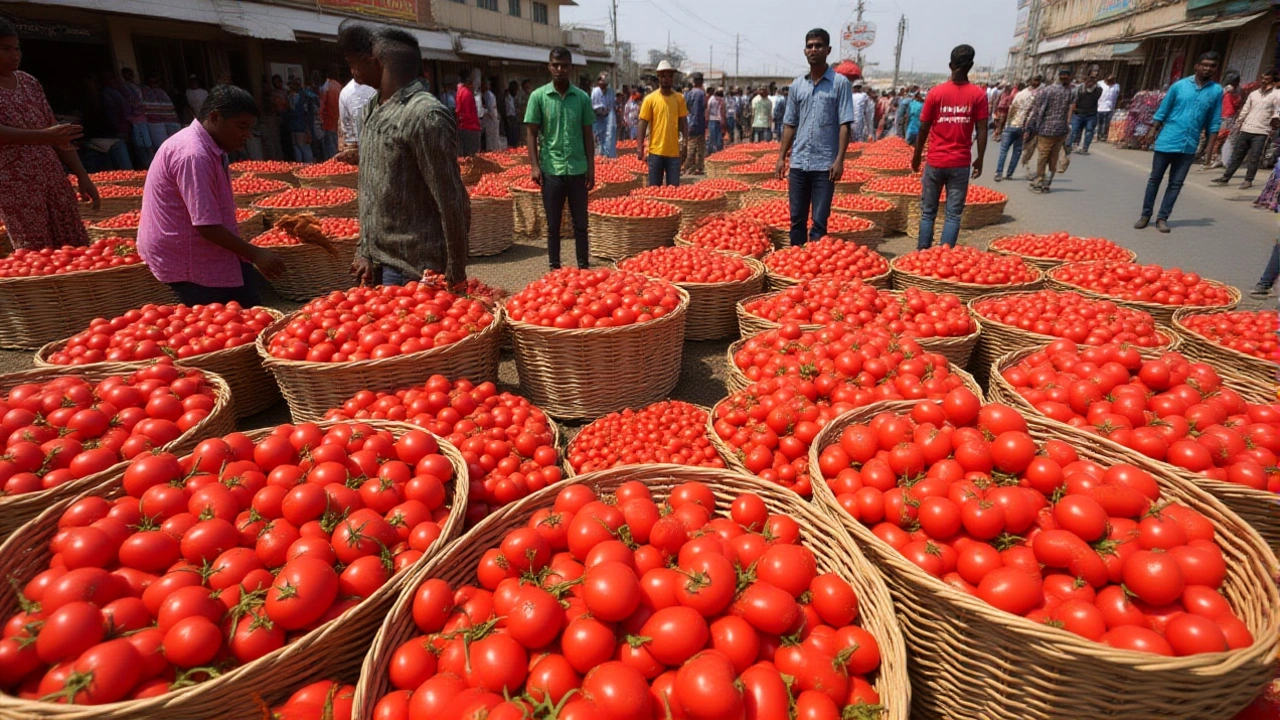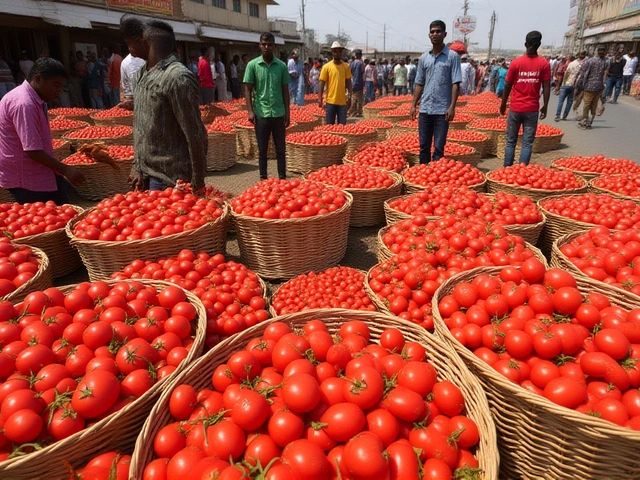A basket of tomatoes in Nigeria dropped from N18,000 to N14,000 in just two weeks — a 22% plunge that left vendors stunned and consumers relieved. The sharp decline, reported by Nairametrics on June 24, 2019, came amid a surprising twist: sellers weren’t celebrating. They were blaming high tariffs on imported rice — a policy meant to protect local farmers — for triggering a chain reaction that crushed tomato profits. Across the country, the National Bureau of Statistics confirmed the trend, noting that the price of 1kg of tomatoes fell 9.4% to N226.07 in June 2019 from N249.52 in May. It wasn’t an isolated blip. February and March had already shown steady declines, with year-on-year drops of nearly 10%. But this? This was a freefall.
Why rice tariffs hurt tomatoes
Here’s the thing: Nigeria doesn’t grow enough rice to feed itself. So when the government slapped high tariffs on imported rice in early 2019, hoping to boost local production, it backfired in ways no one fully anticipated. The cost of importing rice soared, and traders — already stretched thin by forex shortages — started cutting back on other imports. That included packaging materials, fertilizers, even fuel for trucks delivering tomatoes from farms in Kaduna and Benue to markets in Lagos and Abuja. Suddenly, the logistics chain for tomatoes snapped. Farmers couldn’t get their produce to market fast enough. Spoilage rose. And prices? They collapsed."It’s not that people stopped eating tomatoes," said Amina Yusuf, a vendor at Mile 12 Market in Lagos. "It’s that we couldn’t afford to keep them fresh. We lost more to rot than we made in sales. Some days, we gave them away just to clear space."
The rice paradox
While tomatoes tumbled, rice prices also fell — but not because of abundance. The National Bureau of Statistics reported medium rice dropped 2.8% to N308/kg, local rice fell 2.57% to N271/kg, and Ofada rice slipped to N373.50/kg. On the surface, this looked like a win for consumers. But behind the numbers was a deeper tension: importers were dumping stockpiled rice to recover cash, while local farmers struggled to compete with cheaper, subsidized imports that still slipped through the tariff net. The result? A market in disarray — with both staples moving in opposite directions for reasons no one fully understood.Beans weren’t spared either. Brown beans fell 6.16% to N342.62/kg, white beans dropped 5.54% to N311/kg. The pattern was clear: food prices were unraveling, but not because of oversupply. It was about broken supply chains, currency instability, and policy missteps.
Harvest season and the "stability" myth
Economic analysts at Channels Television offered a more nuanced take. In a June segment featuring analyst Haleem, they noted tomato and rice prices remained "stable but elevated" despite the drops. "We’re in harvest season," Haleem explained. "That helps. Logistics costs have stabilized a bit. People are buying more now — not because they’re richer, but because they’re scared of what’s next."That fear was real. Nigeria’s terms of trade had declined 2.8% in Q4 2018, meaning the country got less value for its exports (mainly crude oil) relative to what it paid for imports. The Central Bank had restricted forex access for non-essential goods, but rice — deemed strategic — was granted special treatment. That created a black market for import licenses and inflated costs for everything else. Tomato farmers, who relied on imported agrochemicals and plastic crates, bore the brunt.
Who’s really paying the price?
Urban households spent nearly 30% of their food budget on rice and tomatoes combined, according to NBS data. When tomatoes dropped, families ate more of them — but vendors lost income. When rice dropped, urban consumers breathed easier — but smallholder rice farmers in Kebbi and Delta saw their profits evaporate. Meanwhile, middlemen who controlled import permits and transport routes quietly pocketed the difference."This isn’t about food security," said Dr. Ngozi Okonjo-Iweala, former Finance Minister and now WTO Director-General, in a 2020 interview referencing the 2019 crisis. "It’s about policy silos. You can’t protect one crop by strangling another. The system is designed to fail."
What’s next?
By July 2019, the government quietly eased some tariff restrictions on rice inputs — fertilizers, seed, and machinery — hoping to boost domestic yields. But the damage was done. Tomato farmers had already switched crops. Many planted peppers instead. Retailers began importing canned tomatoes from Egypt and China. The ripple effect? A long-term shift in Nigeria’s food landscape.Today, tomato prices have stabilized — but never returned to pre-2019 levels. And rice? Still expensive. The lesson? When you mess with one part of the food chain, the whole table shakes.
Frequently Asked Questions
Why did tomato prices fall so sharply if rice tariffs were meant to help farmers?
The tariffs raised the cost of importing rice, which strained importers’ cash flow and forced them to cut spending on other goods — including fuel, packaging, and fertilizers used by tomato farmers. This broke supply chains, increased spoilage, and flooded markets with unsellable produce, driving prices down. It wasn’t about surplus — it was about broken logistics.
How did the National Bureau of Statistics track these price changes?
The NBS collects data monthly from 19 state capitals and 360 markets across Nigeria, sampling prices for over 40 food items. Their methodology includes both wholesale and retail prices, with adjustments for regional variations. The June 2019 report confirmed tomato prices fell 9.4% month-on-month, aligning with Nairametrics’ basket-level observation of a 22% drop.
Did the price drop benefit poor households?
Short-term, yes — but long-term, no. While families ate more tomatoes, vendors and farmers lost income, reducing their ability to buy other essentials. Many farmers switched to peppers or cassava, leading to reduced tomato supply in later months. The real beneficiaries were middlemen who controlled imports and transport, not the poorest consumers.
What role did forex shortages play in this crisis?
The Central Bank restricted access to foreign exchange for non-essential imports, forcing traders to rely on the parallel market where rates were 30-50% higher. This inflated the cost of everything from plastic crates for tomatoes to fertilizer for rice. Many small traders simply stopped importing, worsening shortages and distorting prices across the entire food sector.
Were there any policy changes after the 2019 price crash?
Yes. By late 2019, the government began easing restrictions on importing key agricultural inputs like fertilizers and seed — not rice itself — to support local farmers. But the damage to trust and supply chains lingered. Tomato production never fully recovered, and Nigeria now imports more canned tomatoes than ever before.
How does this compare to past food price crises in Nigeria?
Similar to the 2016 onion crisis, where export bans caused domestic shortages, this was another case of policy intervention backfiring. Unlike 2016, however, this crisis involved multiple commodities interacting — rice tariffs indirectly crushing tomato prices. It exposed how Nigeria’s food system is more interconnected than policymakers realized.








Nathan Roberson
October 29, 2025 AT 03:09Man, this is such a wild example of how policy can backfire in the most unexpected ways. You think you’re helping farmers by blocking rice imports, but then tomato vendors are giving away produce just to stop it from rotting. The system’s so tangled it’s like trying to fix one wire in a spiderweb and the whole thing collapses.
Aravinda Arkaje
October 29, 2025 AT 18:21Y’all need to stop treating food systems like a chess game. This isn’t about ‘protecting local farmers’-it’s about recognizing that everything’s connected. Tomato farmers don’t grow rice, but they still need fertilizer, plastic crates, and diesel. When you choke off imports for one thing, you choke off everything else too. Simple as that.
Sagar Solanki
October 29, 2025 AT 23:19Let’s be real-this was never about rice. It was about the Central Bank’s forex mafia and the import license cartel. The tariffs were just a smokescreen. The real winners? Guys with connections who got special access to cheap dollars while everyone else starved. The government didn’t fail. They engineered this. And now they’re pretending to be surprised.
kunal Dutta
October 30, 2025 AT 03:11Interesting how the NBS data shows tomato prices fell 9.4% but Nairametrics saw a 22% basket drop. That’s a classic discrepancy between retail basket vs. weighted average. The 22% is what vendors actually felt-because they’re selling whole baskets, not per kg. The NBS smoothed it out. Both are right. One’s macro, one’s micro.
Yogita Bhat
October 30, 2025 AT 16:31So we punished farmers to help farmers? 😂 The irony is thicker than Nigerian pepper soup. Meanwhile, the real villains? The middlemen who bought up plastic crates at 3x price on the black market and sold them back to farmers at 5x. They didn’t even need to grow anything. Just sit and profit. #CapitalismInAction
Amit Mitra
November 1, 2025 AT 07:57It’s fascinating how deeply interconnected food systems are, especially in developing economies where infrastructure is fragile. The collapse of tomato prices wasn’t due to overproduction-it was a cascading failure of logistics, currency access, and input supply chains. This mirrors what happened in Zimbabwe with maize and diesel, and in Argentina with soy and fertilizer. It’s not Nigeria’s problem-it’s the problem of any economy that treats trade policy like a blunt instrument.
sneha arora
November 1, 2025 AT 09:00My aunt in Lagos used to sell tomatoes every morning. She said after the crash, she’d cry while giving them away. 😢 People think price drops = good, but when the people who grow your food can’t afford to eat? That’s not a win. That’s a tragedy wrapped in economics jargon.
Saachi Sharma
November 2, 2025 AT 09:32They didn’t fix the system. They just gave up and started importing canned tomatoes from Egypt. So much for ‘food sovereignty.’
Vijayan Jacob
November 4, 2025 AT 02:53Oh so now we’re supposed to feel bad for the rice farmers? Bro, they got subsidized inputs, tax breaks, and guaranteed off-takers. Meanwhile, the tomato guy? He got a broken truck, a 50% markup on diesel, and a pile of rotten fruit. Who’s the real victim here? 🤔
Siddharth Madan
November 4, 2025 AT 13:46It’s not just Nigeria. Look at India’s onion export ban last year-same story. Price spikes, then crashes. Farmers lose. Middlemen win. Governments keep doing the same thing and pretending it’s policy, not chaos.
bharat varu
November 4, 2025 AT 22:33Dr. Okonjo-Iweala nailed it. Policy silos. We treat agriculture like separate departments-rice here, tomatoes there, beans over there. But in the field? It’s one ecosystem. You don’t fix one without breaking another. We need integrated food policy, not piecemeal tariffs. This is basic systems thinking.
Thomas Mathew
November 6, 2025 AT 19:10The real conspiracy? They knew this would happen. They wanted the tomato farmers to fail so they could buy their land cheap and turn it into agro-industrial zones. The rice tariffs? Just the bait. The real catch? Land. Power. Control. The poor eat canned tomatoes now. The rich eat organic. The system didn’t break. It evolved.